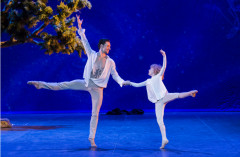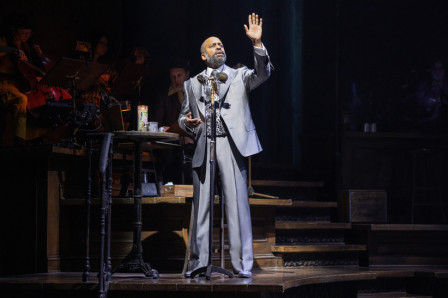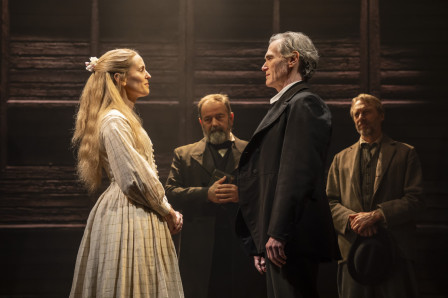Review: SATORI at the London Coliseum
 People speak of Sergei Polunin with the same awe and reverence given to Rudolph Nureyev and Mikhail Baryshnikov. He is another wunderkind of dance, one who attracts headlines for the unorthodox. He is also no stranger to performing in different media, most recently as Count Andrenyi in Kenneth Branagh's Murder on the Orient Express.
People speak of Sergei Polunin with the same awe and reverence given to Rudolph Nureyev and Mikhail Baryshnikov. He is another wunderkind of dance, one who attracts headlines for the unorthodox. He is also no stranger to performing in different media, most recently as Count Andrenyi in Kenneth Branagh's Murder on the Orient Express.
There has been great anticipation for Polunin’s return to London, his home city while he was briefly at the Royal Ballet, being their youngest ever Principal. His demi-god status was confirmed earlier this year by the documentary of his life, Dancer, and his appearance in Hozier's Take Me To Church video, directed by David LaChapelle, which has had over 20 million hits on YouTube.
In truth, I suspect the majority of Polunin fans would have been happy to watch their extraordinary, tattooed hero, dancing in a rehearsal studio in work-light. And this is how he first appears in First Solo, a new short ballet created by the award-winning choreographer, Andrey Kaydanovskiy – stripped to the waist; facing the back wall of the theatre; performing a series of mesmerising shapes. But the choreography is not world-beating, when he turns around for the first time there is not the anticipated roar of excitement from the audience of supporters. Nureyev had works created for him by Ashton, Macmillan and Martha Graham; Baryshnikov had Vinogradov, Tchernichov and Balanchine.
This old-fashioned solo of a tormented man is not helped by the creaky lighting, which manages to be incredibly old-fashioned while using high tech equipment. Moving lights in a solo ballet are never a good idea. What do you watch - a six-foot man, or a thirty foot shaft of moving light? A light that has conspicuously not been choreographed… As in all art, the framing is all-important. The Mona Lisa remains the same whether in a perspex frame or a gilt masterpiece. It's the same with ballet – however good the dancers are, if the artistes are not in their solo spots, or if lamps move in a clumsy way, the overall effect is ill-prepared.
The London premiere of Kasyan Goleizovsky’s ballet suite, Scriabiniana follows. Again, in spite of some fine dancing by the ad-hoc collection of dancers from Munich (and ex-English National Ballet), Hamburg, Stuttgart, Bolshoi and Moscow Academic Music Theatre, this is drearily presented in old-fashioned cross-lighting (dim magenta and turquoise). Yes, there are flashes of brilliance in the dancing - for Polunin's final, dazzling, Spartacus-type solo at the end of the Act, we are given Soviet reds and oranges. But it's all artistically and technically passé; it looks like a ballet from the late 1950s before the advent of John B Read.
The choreography is a bizarre combination of blood and guts and lyricism, abstract like Symphonic Variations or Monotones but not in the same league. Of course it is essential for younger dancers to pay respect to their heritage, but Scriabiniana – originally created in the 1960s – with its quirky lifts and gymnastics, is not a seminal piece. The quality of the dancing by the young company is, however, world-class, especially from Royal Ballet Principal and Polunin’s off-stage partner, Natalia Osipova. At all times her exquisite line and sheer class are an inspiration - an example of how to lead from the front.
In the second Act, Project Polunin presents Polunin’s own choreography for Satori, directed by Gabriel Marcel del Vecchio and with an original score by the multi-award-winning composer, Lorenz Dangel. We are told that, for the choreographer, Satori represents Polunin’s personal journey to reconnect with his love for dance and passion for the arts. Again, a tortured soul looking for the way out. We have been here before.
LaChapelle's set opens with a 3D tree and some extensive video mapping (very hi-tech), leading to the full stage with a blue background and a flying piece that does not behave (very lo-tech). Neither help the choreography or story-telling in any way whatsoever; again it is a disaster to mix contemporary moving lights with a classical 2D set. Sometimes the dancers are underlit, sometimes they are transfigured in white light without rhyme or reason.
But Polunin is a force of nature and his choreography fits his body like a glove. You cannot be anything other than impressed by both and his two fellow soloists in this piece, the 11-year old Tom Waddington and the willowy Ljiljana Velimirov.
Satori is a lavishly produced evening of huge potential talent, let down by a technical team who perhaps are not motivated to excel. Project Polunin aims to make dance accessible to people of all ages and incomes, and to inspire, nurture and support young people to be more creative. Hopefully, with more trips to major cities around the world, the focus will be on the charismatic dancers at the heart of the project and less clutter with the lighting, set and costumes.
It is to be hoped that a world-class choreographer will soon emerge to lead the company on to greater things.
Latest News

 Daniel Breaker joins West End production of Hadestown
26 December 2025 at 21:46
Daniel Breaker joins West End production of Hadestown
26 December 2025 at 21:46

 London Productions 2025 - A Year in Review
26 December 2025 at 21:11
London Productions 2025 - A Year in Review
26 December 2025 at 21:11

 Production images released for HIGH NOON
24 December 2025 at 10:54
Production images released for HIGH NOON
24 December 2025 at 10:54

 Full Cast Announced for SHADOWLANDS in the West End
22 December 2025 at 13:14
Full Cast Announced for SHADOWLANDS in the West End
22 December 2025 at 13:14
